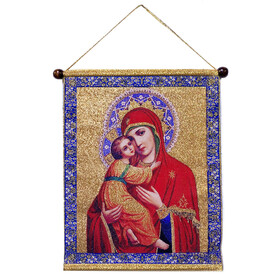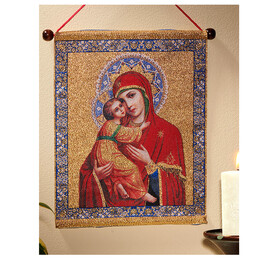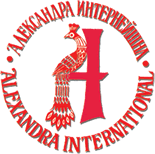BANNERS – A “CALL TO ACTION”
ALEXANDRA INTERNATIONAL is excited to introduce a new line of tapestry banners that captures for “private devotion” sacred images meant to “teach” and “direct” us.
There are many reasons for a banner – perhaps the most compelling to a Christian is a banner is a “call to action.” This call to action can be expressed in words (for example “XB” for “Christ Is Risen!”) symbols (the Holy Cross), and depictions of holy images for us to immolate – for example, Christ (example the Holy Face – Made Without Hands) the Virgin Mary (Theotokos) or a saint.
In the Old Testament God commanded the use of visual aids toremind the Israelites on what is important “…to look at and so you will remember all the commands of the Lord.” Banners rallied the Twelve Tribes. It is believed the color of each tribe’s banner corresponded to the color of the tribe’s stone on the Brest Plate of the High Priest.
Both the Eastern (for example,
the stunning “Khorugv” banners used in Russian
churches) and Western (for example, the famous art banners of European Cathedrals
as well as banners used by the Vatican when proclaiming a new saint) Christian churches
used banners reminding us of the ”presence of God” in our lives.
They are meant to
“remind,” “teach” and provide “direction”
in our spiritual lives.
A Brief History of the VLADIMIR MOTHER OF GOD Icon
An
icon to the Eastern Christian is a “window to the eternal.” The icon connects the created to his creator
and His saints. The Virgin Mary is
epresented in over 350 different icons that have special significance to the
religious life of the Russian people.
While all icons play a part in the religious life of Russia, some played
a part in the historical and political development of Russia.
The Vladimir Mother of God icon, a variation of the “Eleousa” or “Tenderness” iconographical type, is the most beloved icon of all Russia. Orthodox tradition holds St Luke the Evangelist, the first iconographer, wrote (painted) the original “Vladimir” icon on boards from the table in the home of the Holy Family in Nazareth. It is believed St Luke knew the Virgin Mary and many of the Apostles; therefore, his representations are the pattern for later icon paintings. The letters “MP” and “O (Phi) Y” on either side is the Greek abbreviation for Mary as the “Mother of God.” The “stars” on her head and shoulders represent Mary’s virginity.
The icon was taken from Jerusalem to
Constantinople, the capital city of the Eastern Byzantine Empire, in 450AD. The
Russian Chronicles tell us the icon was taken from Constantinople during the
reign of Prince Yuri Vladimirovich Dolgoruky (1090s-1157) to the women’s
monastery of Vyshgorod in Kiev (Rus – the first capital of pre-Russian state)
and preformed many miracles there. The
icon appeared to Yuri’s son, Prince Andrei Yurievich Dolgoruky, directing him
to take the icon to the city Vladimir-on-Klyazma. With great devotion the icon was installed
in the Church of the Dormition performing many great miracles. There the icon became known “Vladimir Mother
of God.”
The
“Vladimir” icon is celebrated three times in the Russian Orthodox liturgical
year: (1) May 21st to
celebrate the icon’s helping to save Russia from the invading Crimean-Nogay
Horde of Makhmet-Girey; (2) June 23rd
in thanksgiving to the protection of the Mother of God from the Golden Horde’s
Khan Akhmet in 1480; (3) and the commemoration of the Meeting of the
Wonder-working icon in 1395 during the invasion of Moscow by the Tartar forces
of Tamerlane.
The
icon is housed in the Tretyakov Gallery in Moscow. The ownership of the icon was in question
after the fall of the Communist government.
The Church obtained ownership of the icon but the maintenance of the
icon is the responsibility of the Russian state.
Icon Measures 10 1/4 inch x 7 3/4 inch
Including Wooden Parts 8 3/4 inch wide
Including Hanger Part from top to bottom 14 inch tall




